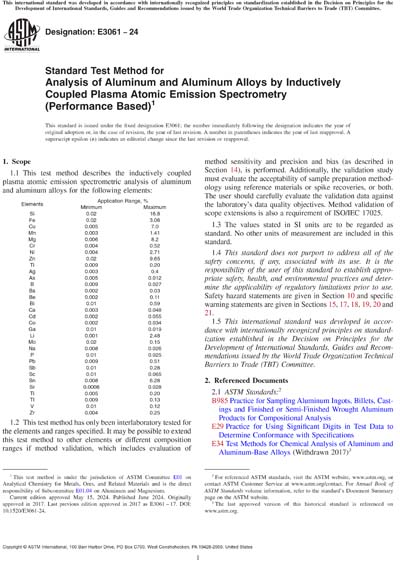Most recent
ASTM E3061-24
Standard Test Method for Analysis of Aluminum and Aluminum Alloys by Inductively Coupled Plasma Atomic Emission Spectrometry (Performance Based)
1.1 This test method describes the inductively coupled plasma atomic emission spectrometric analysis of aluminum and aluminum alloys for the following elements:
| Elements | Application Range, % | |
| Minimum | Maximum | |
| Si | 0.02 | 16.8 |
| Fe | 0.02 | 3.06 |
| Cu | 0.005 | 7.0 |
| Mn | 0.003 | 1.41 |
| Mg | 0.006 | 8.2 |
| Cr | 0.004 | 0.52 |
| Ni | 0.004 | 2.71 |
| Zn | 0.02 | 9.65 |
| Ti | 0.009 | 0.20 |
| Ag | 0.003 | 0.4 |
| As | 0.005 | 0.012 |
| B | 0.009 | 0.027 |
| Ba | 0.002 | 0.03 |
| Be | 0.002 | 0.11 |
| Bi | 0.01 | 0.59 |
| Ca | 0.003 | 0.048 |
| Cd | 0.002 | 0.055 |
| Co | 0.002 | 0.034 |
| Ga | 0.01 | 0.019 |
| Li | 0.001 | 2.48 |
| Mo | 0.02 | 0.15 |
| Na | 0.008 | 0.026 |
| P | 0.01 | 0.025 |
| Pb | 0.009 | 0.51 |
| Sb | 0.01 | 0.28 |
| Sc | 0.01 | 0.065 |
| Sn | 0.008 | 6.28 |
| Sr | 0.0008 | 0.028 |
| Ti | 0.005 | 0.20 |
| Tl | 0.009 | 0.13 |
| V | 0.01 | 0.12 |
| Zr | 0.004 | 0.25 |
1.2 This test method has only been interlaboratory tested for the elements and ranges specified. It may be possible to extend this test method to other elements or different composition ranges if method validation, which includes evaluation of method sensitivity and precision and bias (as described in Section 14), is performed. Additionally, the validation study must evaluate the acceptability of sample preparation methodology using reference materials or spike recoveries, or both. The user should carefully evaluate the validation data against the laboratory’s data quality objectives. Method validation of scope extensions is also a requirement of ISO/IEC 17025.
1.3 The values stated in SI units are to be regarded as standard. No other units of measurement are included in this standard.
1.4 This standard does not purport to address all of the safety concerns, if any, associated with its use. It is the responsibility of the user of this standard to establish appropriate safety, health, and environmental practices and determine the applicability of regulatory limitations prior to use. Safety hazard statements are given in Section 10 and specific warning statements are given in Sections 15, 17, 18, 19, 20 and 21.
1.5 This international standard was developed in accordance with internationally recognized principles on standardization established in the Decision on Principles for the Development of International Standards, Guides and Recommendations issued by the World Trade Organization Technical Barriers to Trade (TBT) Committee.
ASTM International [astm]

